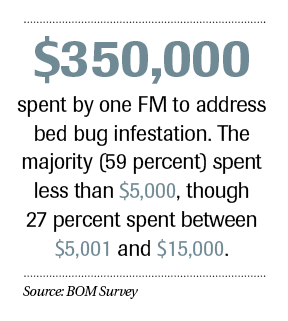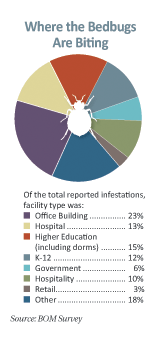Survey: How Facility Managers Have Taken the Bite out of Bed Bugs
The first report of bed bugs on Wake Forest University's campus came just days into the 2010 fall semester. Following a canine inspection, several affected dorm rooms were identified. By the end of the month, dozens of rooms were affected. The decision was made to inspect the entire freshman side of campus — about 800 rooms — with canine teams.
A few more areas of concentration were identified. All affected rooms were heat-treated to follow up on some pesticide treatments done at the very beginning of the semester to gain ground quickly against the bed bugs. Over the course of the year, hundreds of rooms were affected and treated. The university now has a policy to sweep all residential units with canine inspection after major population changeovers and treat affected rooms if the dogs indicate that bed bugs are present.
"Everything was surprising," says Bill Yost, assistant director of housing at Wake Forest. "Just the magnitude of it was very surprising." As was the level of strategy it required. The Residence Life and Housing staff had to figure out what to do about winter and spring break. And fall move-in.
"You have 3,300 people moving in with everything that they own," Yost says.
Bed bugs are unlike other pests in that facility conditions don't lure them in, the way that cockroaches are attracted by open food in a breakroom, for example. They are tiny, the size of apple seeds at adult size, and phenomenal hitchhikers on personal belongings. They have been around for ages, but the U.S. public is only now beginning to get reacquainted with them. Their population in the United States has boomed for a variety of reasons, such as increased global travel, decrease in use of certain pesticides and general ignorance as to what they are and how to deal with them.
And they are unlike other pests in that they carry a stigma and elicit a potentially intense emotional/psychological reaction, unwarranted though it may be, that requires facility managers to educate themselves on the tiny invaders, create a response plan that covers both physical treatment of an infestation and internal and external communications policy, and react quickly and decisively to mitigate the negative effects of the discovery of bed bugs.
At least, that's what the experts say. Despite the problems that bed bugs have the potential to cause, facility managers who haven't been affected generally aren't very worried about the pests, according to a survey conducted by Building Operating Management.
Of 515 survey respondents, almost a quarter (23 percent) reported having had bed bugs at their facilities, with an average of three facilities in their portfolio affected. Of the 77 percent of respondents who said they had not been affected, 72 percent are not doing anything to monitor for bed bugs and 43 percent are not at all concerned they will be affected. Only 6 percent were seriously concerned and 51 percent were somewhat concerned.
Among those reporting no infestation, 28 percent report monitoring for bed bugs, with visual inspection being the most prevalent step taken (83 percent). Visual inspection was also prevalent among facility managers who had been affected by bed bugs, at 75 percent.
Visual inspection is a valid and important strategy in monitoring for bed bugs, but it is only one in many steps that can be taken and it doesn't work very well for many types of property. As a preventive measure, visual inspections work best in places where there is a sleeping person.
"When you get to office buildings, daycare, retail, it can be maddeningly difficult to find bed bugs in those early stages because there's no sleeping human, which is the main attractant to congregate," says Michael Potter, professor and urban entomologist at the University of Kentucky. "It's like hunting a needle in a haystack in these types of situations, especially with visual inspection."
As their name implies, bed bugs are most closely associated with the places where a host sleeps or sits still for prolonged periods of time. But that doesn't mean they stay there; instead, they hitch a ride on pant cuffs, backpacks, or books and go anywhere a person goes. Movie theaters. Changing rooms. Schools. Office buildings.
The increase of the general population of bed bugs means that they are being introduced in greater numbers in all types of facilities, even if the spaces are not the ideal environments to establish a breeding population. In the Building Operating Management survey, the facility types reporting being affected by bed bugs ran the gamut from hospitality to hospitals, K-12 to government facilities. (See chart below.)
Just because non-residential environments are not likely places for bed bugs to establish breeding populations doesn't mean facility managers can be casual in their response, or that it will be cheap. The Council on Foreign Relations, a 55,000 square foot facility in New York City with about 200 employees and staff, has had two bed bug events. The number of bed bugs found was small. The response was not.
Early last year, a suspicious insect was spotted crawling up a wall in an area with eight workstations. It was trapped by an employee and confirmed as a bed bug by a pest management company. A canine unit inspected the entire facility and identified the main area of infestation. The employees in that area were asked to work from home until the space — and their homes — could be cleared by canine inspection.
In the facility, the affected area was steam cleaned and vacuumed, then resinspected by dogs. Any further hot spots were removed and heat-treated or recleaned with steam. Then the dogs came back to give a final all clear. All said, it took a week and $20,000, says Ian Norray, deputy director of facility operations at the Council.
The second incident involved an employee in an office shared with three other employees. The employee reported having bed bugs at home, so the office was inspected and the employee worked from home until she could document that her home was clear.
Bed Bug Control
In the future, Norray says, they are planning twice-yearly inspections with canine units and dealing with problem spots quickly and quietly, without unduly alarming staff.
"There are much worse things than bed bugs, like cockroaches and rats," Norray says. "All a bed bug wants is a nice warm meal. No different than you and me. They don't pass on diseases, to my knowledge."

Related Topics:
















